Visiting Hobbiton, New Zealand’s Hobbit set! The Shire location, Lord of the Rings movie tour.

If I had to pick the highlight of my Contiki New Zealand adventure… it would be my tour of Hobbiton, the Lord of the Rings and Hobbit movie set!
LOTR director Peter Jackson personally scouted this spot for his films, and had his team build a Hobbit village from scratch. These Shire scenes are some of his most memorable, and put New Zealand’s idyllic landscapes on the map.

The “Hobbit holes” were too cute to tear down, so Peter Jackson agreed to preserve them as an attraction. Today, fans from around the world come to frolic in the footsteps of Frodo, Bilbo and Gandalf.

As you can see from these photos, it felt like I had stepped right into Middle Earth!
Read on for the scoop on how to visit Hobbiton, and photos of the famous set locations — including the Green Dragon Pub, Mill, and double-arched bridge.

First, a primer for those who aren’t familiar with Hobbits. These tiny, furry-footed creatures are a human-like race in the J. R. R. Tolkien fantasy novels: Lord of the Rings Trilogy and The Hobbit. (These books are cult favorites, and I encourage you to read them all.)
In the 2000s, director Peter Jackson released three Lord of the Rings movies, followed by the Hobbit trilogy. The films were box-office successes and generally loved by fans. All of the outdoor scenes in the Shire (home of the Hobbits) were filmed right where I’m standing.

I’ve written before about the ease of travelling with Contiki, a travel company for 18-35 year olds. Our tour manager Monique gave us info on the best activities in the North Island, including Hobbiton. If we wanted to book, she did all the arrangements for us, including drop-offs and passes! Contiki’s prices are also lower than if you reserved the same tour on your own.
(Close-up of my Alex Streeter Gothic rings, and nail art by Glam Nail Studio).

Most visitors come in from Rotorua, the Maori hot springs town about three hours south of Auckland. (We spent time here with Contiki; I’ll show you more in the next post).
The Hobbiton bus picked us up from our Rotorua hotel, and we enjoyed an hour-long drive through bucolic farms and the Kaimai Ranges.
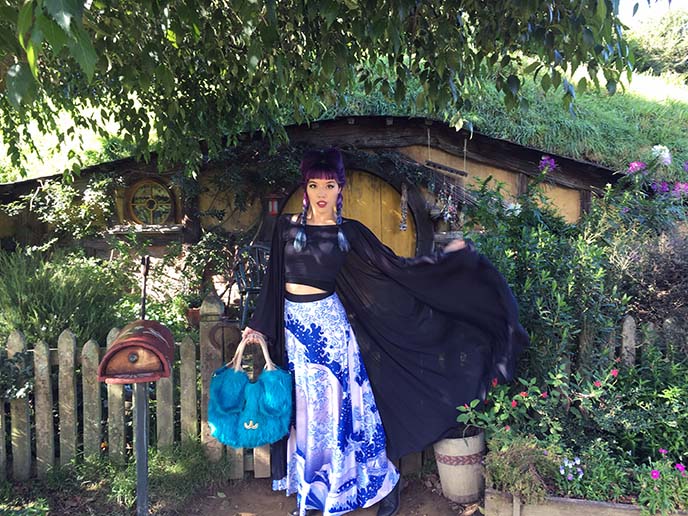
If you want to drive here on your own, Hobbiton is located in Hinuera, Matamata. Note that you can’t visit the adorable set unless you join the official tour, so book early as the spots fill up quickly.
We met our energetic guide, and she took us on a two-hour tour of the twelve acre site. She told us juicy behind-the-scenes tales, and led us to every area of the Shire with lots of time to take photos.

I’ve been to some movie sets that feel like cheesy theme parks. Thankfully, Hobbiton is nothing of this sort.
I walked through these gorgeous gardens, basking in the patches of sunlight and scent of flowers.

The designers put remarkable thought into every aspect of the village, and never ruin the effect with modern incongruities or cash-grabs. (I’d die if there were a souvenir vendor in front of the Baggins’ home!).
Tolkien fans will appreciate details like this signpost, which shows the “farthings” or subdivisions of the Shire.

Some of the “Hobbit holes” have fences that prevent you from going into the yard, but you’re welcome to play with the props outside. Let me tell you… that wheelbarrow was heavy!
Check out the clothesline hanging above the house. Hobbits are about the size of human children, and their garments are adorable.

Hobbiton gives you a glimpse of daily life in the shire. Next to a pumpkin patch, there was a rack of (fake) dried fish.

How did this paradise come into being? Our guide told us that director Peter Jackson spotted this slice of New Zealand countryside from the air, as he searched the North Island for shooting locations. He immediately knew that Alexander Farm (as it was known) was perfect for Lord of the Rings.

Peter Jackson took up temporary residence in a nearby farmhouse, and oversaw the massive set transformation. His team of builders turned the bare Waikato farmland into a real-life version of Tolkien’s Shire.

The houses look outstanding in the films because everything was built at the highest standards. The wood, plants and glass are all the real deal.
But here’s something you might not know… Almost all of the Hobbit holes are only exteriors! There’s nothing behind the round doors, as the indoor scenes were filmed in a Wellington studio.

The Hobbiton tour does takes you to one red door, where you can duck your head and pop inside. (Since Hobbits are little, all the structures are sized down to fit them.)

Our guide pointed out where key scenes in LOTR were shot. She showed us the pond, and the fence that Frodo Baggins jumped over in The Fellowship of the Ring.

Outfit details: My “Great Wave” skirt from Black Milk Clothing is currently my favorite item in my wardrobe. The floaty material and Hokusai print are a stand-out.
Everyone in Lord of the Rings seems to wear a cloak, so I paired it with a black cape (similar) and matching blue purse.

I gained a new appreciation for Peter Jackson’s movies during the Hobbiton set tour. Our guide told us stories of the hard work that went into the making of LOTR. For example, the oak tree overlooking Bag End is actually a stump, which was hand-decorated with thousands of artificial leaves!

The film crew built about 40 Hobbit holes for the Shire scenes. I learned how they used tricks in perspective to make Gandalf (played by Sir Ian McKellen) seem much taller than Frodo (Elijah Wood) and his fellow Hobbits.

Close-up on my Alex Streeter claw and skull rings, and realistic-looking prop pots of honey.
As I previously mentioned, most of the indoor and special effects scenes were shot in Wellington. If you come to NZ’s capital city, don’t miss out on the Wellington Lord of the Rings Movie tour.

No special effects needed, to bring out the beauty of New Zealand’s fields. The cows and sheep are also the real deal.

Quite a few fans dress up in Lord of the Rings costumes, for the Hobbiton tour. While I didn’t do a full cosplay, I paid tribute to Middle Earth by wearing a dramatic cloak.

You can’t take the fake pastries home with you… but there’s a gift shop at the entrance, called the “Shire Store.” Inside, you can purchase a wide range of products like posters, action figures, and Gandalf’s wizard hat.

One of the most charming natural features of Hobbiton: there were butterflies everywhere! I saw white and colored wings fluttering over the flower gardens, and managed to take this photo of one drinking nectar.

Tip: bring both sunscreen and a light jacket, since the weather can change quickly. I encourage you to check the weather forecast on the day you’re visiting Hobbiton (and remember, it’s advisable to book your tour slot and bus ride well in advance).

And bring your best camera — you don’t want to miss out on the unbelievable photo ops! (These photos are taken with my favorite travel camera, the light but full framed Sony alpha 7, a mirrorless DSLR.)

I think author JRR Tolkien would be thrilled about how Hobbiton brought his world to life. We crossed the stone bridge and passed the Mill House, on the way to the Green Dragon Inn.

Hobbiton produces their own Southfarthing range of ales, ciders and ginger beers. This giant barrel was near the May Pole and party field.

At River Churn, we passed The Old Mill that was owned and run by the Sandyman Family, according to the fantasy novels.

Hobbiton does a wonderful job at creating an authentic setting for fans. There’s also a limited number of spots per tour, so the set doesn’t feel overly crowded with tourists.

The homes feel so real that I half expected Hobbits to pop out behind me!
(Photos by Salima Remtulla)

At the end of the tour, we headed inside the The Green Dragon Inn. This is the bar and meeting-place for the locals, as featured in the Lord of the Rings and Hobbit movies.

The scenes inside the inn were actually shot in the Wellington studios, but Hobbiton faithfully recreated the pub for fans to visit.
How charming are these messages left by Hobbits? “Lost, green cloak! If found, please return to the Ivy Bush.”

Everyone got a free Southfarthing beverage (ale, cider or ginger beer) and could order country fare at the counter (cheese scones, meat pies and more). From the dragon decor to the round windows, this is a perfect reproduction.

I was tempted to apply for the “Cooper Wanted” job, so that I could stay here forever…

What more is there to say? Hobbiton captured my imagination, and was one of the best moments on my New Zealand journey.
I hope this post inspires you to watch the Hobbit movies, and read J. R. R. Tolkien’s marvellous books: Lord of the Rings Trilogy and The Hobbit.

So grateful to Contiki for sending me to Hobbiton. I thoroughly enjoyed travelling with Contiki (on a bus with other millennials) on their Sun and Steam New Zealand trip. Be sure to check them out; they offer tours to destinations around the world.
Are you a LOTR fan? Have you heard of this Hobbit heaven before?
SHARE & COMMENT
Waitomo’s magical Glowworm Caves! New Zealand with Contiki, group tours for young travelers.
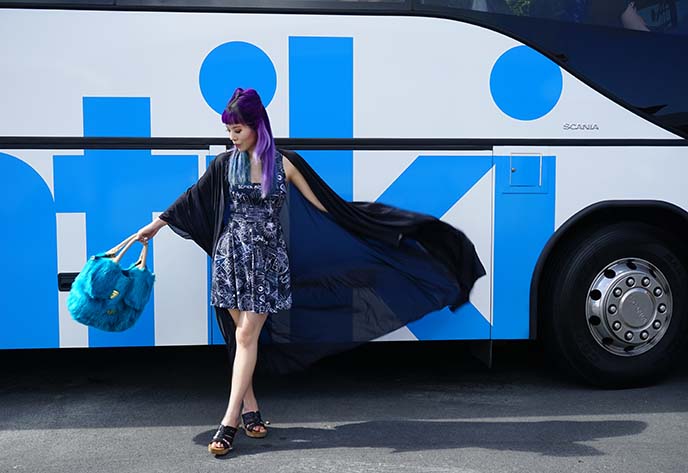
Ready to see more of New Zealand? After exploring Auckland, I hopped back on my Contiki bus for a ride to Waitomo, home of the famous glowworm caves.
These otherworldly caverns, shimmering with blue pinpricks of light, are known as one of the world’s most dazzling natural wonders.

Before we descend into the caves, let me tell you more about my trip with Contiki, a tour group company for 18-35 year olds. They lead journeys all over the world — Southeast Asia, Europe, South America and more — in different lengths and styles.
Above is a pic of my NZ “Sun and Steam” squad! Most people came on the trip alone, and quickly made friends. I found my Contiki group to be very inclusive, especially thanks to the friendly tone set by our tour manager Monique and driver Dyson.
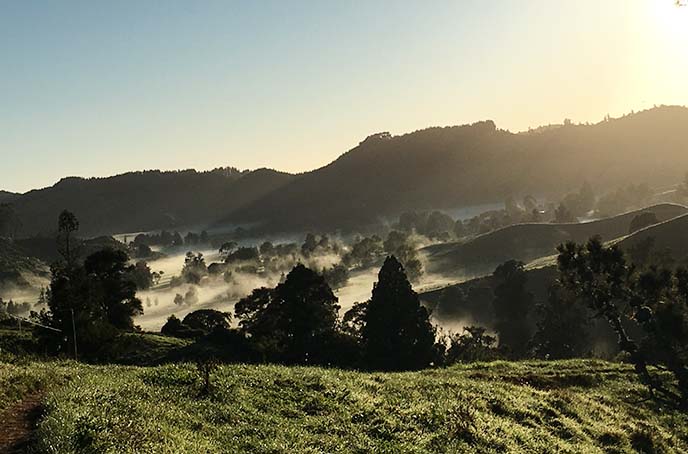
We traveled about three hours from Auckland to Waitomo, with rest stops and lunch. Instead of agonizing over routes and directions, I could just sit back, chat with fellow young travellers, and enjoy this mystical view from the Contiki bus.
After seeing this misty mountain view, I’d say New Zealand lives up to its reputation as one of the world’s most scenic countries.
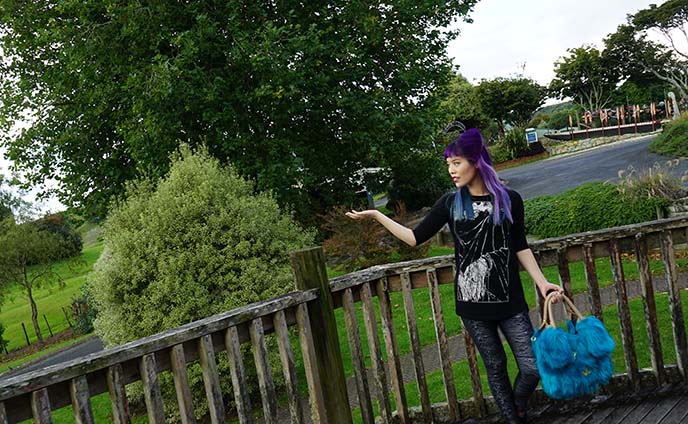
I didn’t even have to waste time on checking in; tour manager Monique simply handed us a key. In Waitomo, we stayed in this cute treehouse-style hotel. (When you book the tour, you can opt to share rooms, or have a single to yourself.)
(Outfit Details: Gothic shirt by Disturbia. My purse is from Shibuya; it’s similar to this blue furry bag, and this blue handbag with a face.)
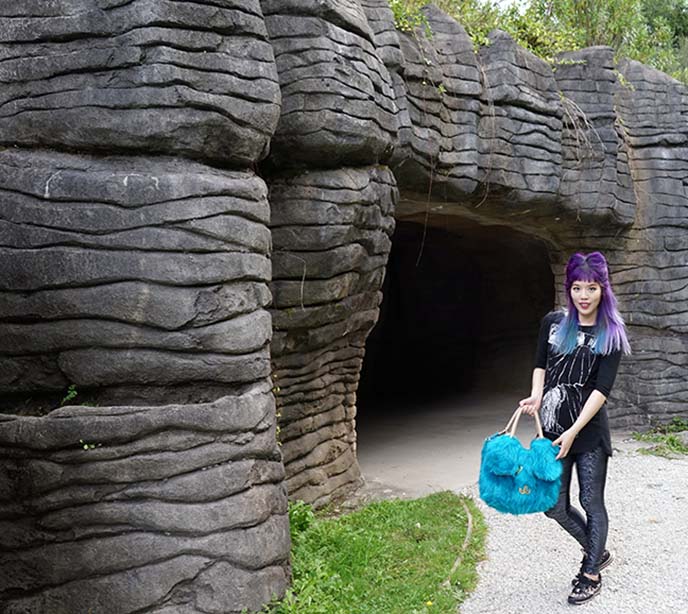
Every Contiki tour has a mix of included and optional activities. Before arriving in each destination, Monique gave us an entertaining overview of the various activities we could add on. She’d then make the bookings for us (once again, I had nothing to stress about).
Waitomo is considered one of the world’s “1000 places to see before you die” because of its glowworm caves. I joined the Ruakuri cave tour since you’re allowed to take photos inside. (In Maori, “Rua” means den and “kuri” means dog… making my blue puppy-faced bag an unintentional match!)

This cave was first discovered about 500 years ago by a young Maori, who was chased by a pack of dogs living inside (hence the name Ruakuri). Today, visitors can join a two hour walking tour that takes you deep inside.
We started by going down this spiral staircase: a scene straight out of the apocalyptic Silo novels. In the dim light, the people around me seemed like ghosts fleeting by.

Before entering, our guide encouraged us to take part in a Maori purification ritual: you run your hands under the falling water, and then touch your head with it, as a gesture of respect. Photographer Salima Remtulla shows how it’s done.
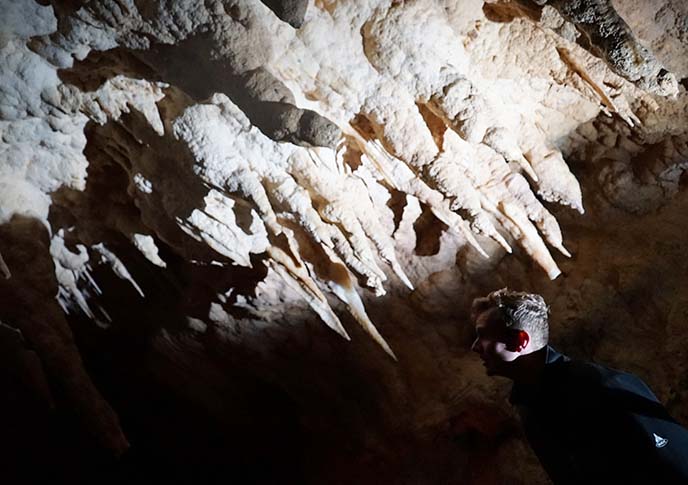
The further we walked, the more we felt like we had entered a subterranean alternate universe. Our guide pointed at underground waterfalls and explained the spectacular natural formations. He taught us a heuristic to differentiate stalactites and stalagmites; the former hangs “tight” to the ceiling!
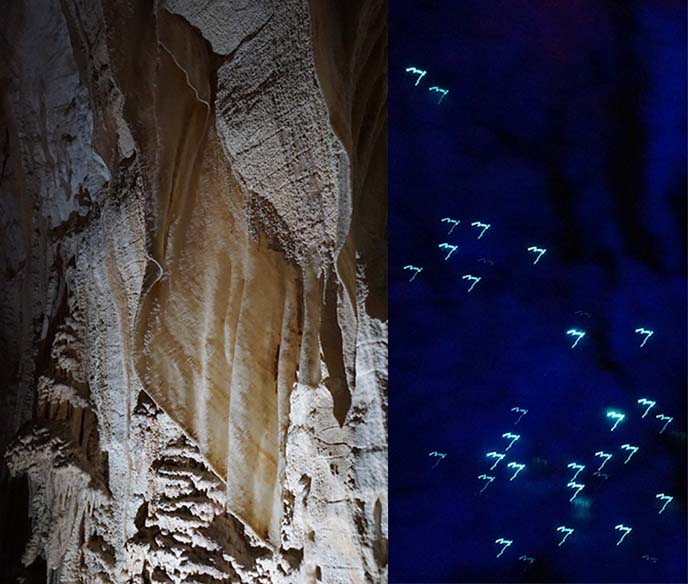
These cave curtains look like they were sculpted by Michelangelo. In fact, they are calcite formations made over millennia, from water running down the roof of the cave. It’s remarkable how much these “speleothems” look like wavy sheets of fabric.
On the right: we got our first glimpse of the glow worms. The insect, Arachnocampa luminosa, is unique to New Zealand and dots the walls of the caves. In certain areas, you’ll see thousands of these creatures radiating blue luminescent light.

These “worms” are actually fungal gnat flies in a larval stage. Our guide shone a flashlight on a ledge, and we saw that each had dozens of long, sticky threads hanging down. These fascinating creatures emanate a blue light that attracts flying insects, which then get stuck on the lures and eaten.

It’s hard to capture the astonishing glow in photos, especially in the dim caves. To the human eye, they look like pinpricks of blue light, almost like constellations.
The glowworms produce “cold” light (with no generated heat) as the result of bioluminescence, a biochemical reaction using the energy-rich protein, ATP.

While I was on my walking tour, other Contiki friends signed up for Black Water Rafting, which also takes place in Ruakuri cave. In this adventure activity, they donned wetsuits and explored the caverns on rubber tubes. (Above photo by John Contompasis)
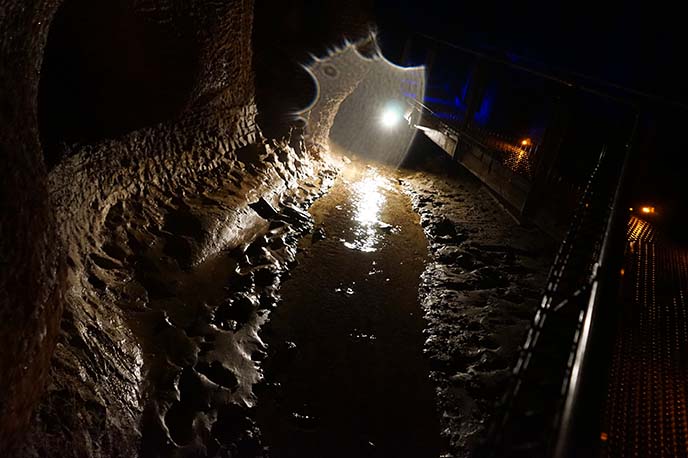
The Blackwater Rafters trekked and climbed through the passages. They took leaps over small waterfalls, and linked up to float through while looking at the glowing worms. (As mentioned before — Contiki has options for every type of traveller, including more adventurous folk).

Waitomo’s glowworm caves are a dazzling experience, and truly must be experienced in person.
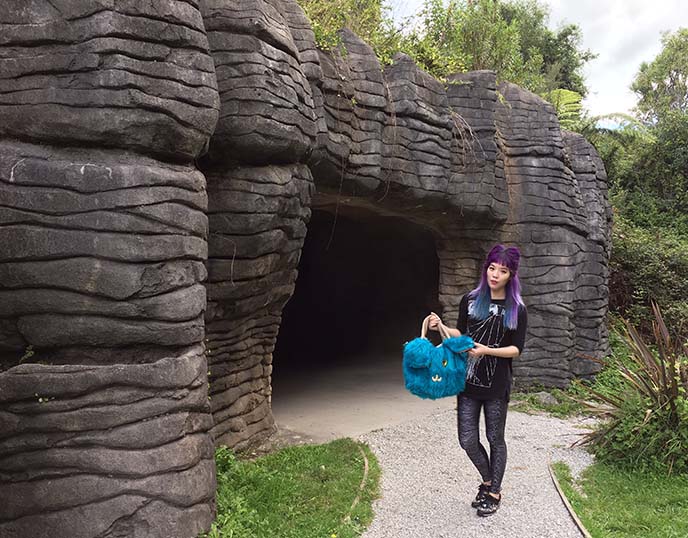
If you come to Auckland, I encourage you to make the trip to Waitomo — an easy journey, thank to Contiki.

From the photo above, I think you can tell that my Contiki group bonded quickly! We still keep in touch regularly through a Facebook group; Contiki’s website also has meetup forums so members can connect before and after a tour.
Everyone was between 18 and 35 years old, and came from various parts of the world. Most of us were citizens of Canada, UK, Australia, and the US.

Most of the travellers came alone, and had different reasons for joining the trip to New Zealand. Some had just finished university, or were on a gap year. Others were going through life changes, and this was their opportunity to try something outside their comfort zone.
The Contiki motto, #NoRegrets, sums up this mindset — and is proudly plastered on the side of the bus.

As you can see, Contiki has top-of-the line buses. The interiors are new and clean, there’s great air conditioning, and even WiFi and charging stations.
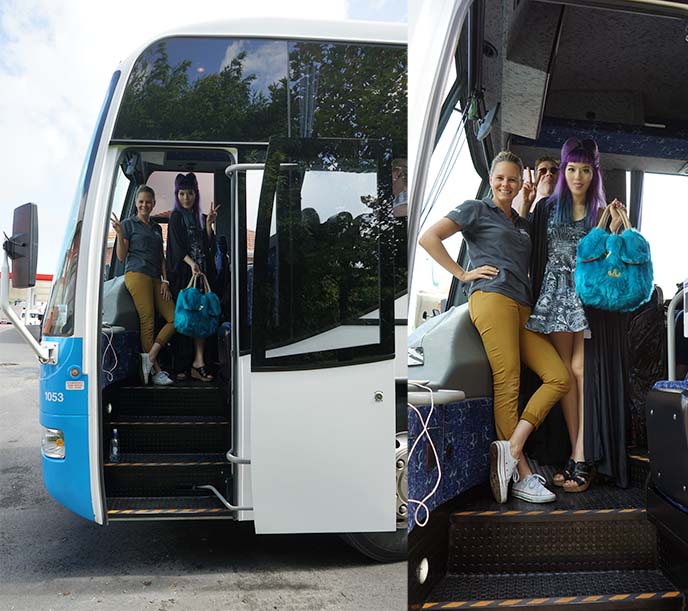
Our tour manager Monique and driver Dyson made the trip a blast. They’re full of passion about New Zealand, and gave insight into every place we visited — along with a “dad joke” or two!
I’ve been on some tours where the guides keep to themselves, but Mon and Dys were the exact opposite. They joined our group dinners and nightlife excursions, and knew every single person by name. We shared a lot of laughs and bonding moments on our week-long road trip together.
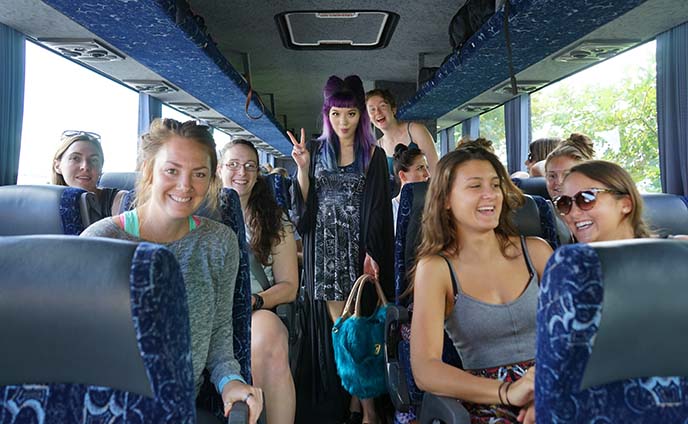
Time flew by, as we rode from one destination to the next. Everyone chatted, played games, and listened to the music piped over the speakers.
Since we were all around the same age, it was easy to connect over shared interests. Quite a few had done Contiki trips before, and loved the experience so much that they were back for more.

Here’s a closeup on my Gothic dress. Black Milk also makes this in a Game of Thrones style.

My spooky rings and bracelet are from Alex Streeter, my favorite jewelry maker. His designs are inspired by outer space, animals, dark culture; perhaps you’ve seen his pentagram ring, worn by Marilyn Manson and J-rocker Hyde.
Alex Streeter is a legend in Japan, where he travels every year, and has a storefront in New York’s Lower East Side. I asked Glam Nail Studio (based in Vancouver, Canada) to create starry nail art inspired by his works.

I leave you with a close up of my Black Milk dress and cape.
What do you think of my Contiki trip so far? Would you join a group tour with young travelers, like I did?
 LA CARMINA
LA CARMINA






